A BRIEF HISTORY
of the
National Weather Service Alaska Region Hydrology Program
During the 20th Century and Beyond
by
Gerald J. Nibler
June 2000
(with subsequent updates)
The history of the National Weather Service (NWS) hydrology program in Alaska is told mostly through its people but also in the hydrologic events, experience, the technology used, and the services provided. This history will focus on the people who served in the Region's hydrology program over the years. The events, technology and the service components will be integrated into the story of the people. Most of this story is the recollection and experience of the author except for those events prior to 1970, which are recalled from conversations the author had with the principal players during the early 1970's.
Note: The US Weather Bureau was the pre-1970 ancestor to the NWS. Early documents refer to the US Weather Bureau Regional Office in Anchorage whereas later documents refer to the Alaska Region Office so the acronym used here in reference to this office will be ARO and reference to either the WB Alaska Region or the NWS Alaska Region will be AR. The US Weather Bureau (WB) became the National Weather Service in 1970 when the Environmental Science Services Administration (ESSA) became National Oceanic and Atmospheric Administration (NOAA).
As early as 1948 the US Weather Bureau Regional Office in Anchorage was involved in planning for a rain gage network specifically intended for hydrologic purposes when the Bureau of Reclamation requested the ARO to install and operate a storage gage on the Eklutna River Basin in South-central Alaska. Later in 1954 the ARO was requested to provide seasonal inflow forecasts for the Eklutna hydroelectric project, but due to a long budgetary drought the Weather Bureau Headquarters in Washington turned down the request for funds for the storage gage. They also turned down the request for inflow forecast services due to lack of expertise in developing procedures in an area with complicated hydrology and no data.
The Weather Bureau hydrology program in Alaska got its formal start from the disaster survey team investigating the great 1964 Spring breakup flood in the Interior of Alaska. Based on the team's recommendation, in 1965 Otto Prexis and Bob Eckdale were hired to staff the startup hydrology program in the Alaska Region. Otto was the Regional Hydrologist and Bob the Region's hydrologic technician. A number of river gages were installed around the state during the first years. Then, in August 1967, the record breaking Chena-Tanana flood occurred. The Weather Bureau was subject to some criticism due to inadequate service during this flood and the Regional Hydrologist ended up shouldering much of the blame for the quality of the warnings issued for the Fairbanks area. Otto had very little data or forecast procedures to work with since the hydro program had only been in existence for two years. In spite of this, Otto was reassigned to the Office of Hydrology in Weather Bureau Headquarters in Silver Spring where he worked until retirement.
Glenn Audsley was named Regional Hydrologist for the Region in 1968 following Otto's departure. Glen came from the Cincinnati River Forecast Center where he was the principle assistant to the Hydrologist-In-Charge. Glen hired Curt Green and Julius Moor as hydrologists on his staff. Between Curt, Julius and Bob Eckdale much of the slope river gage network was established on the Interior rivers. The slope gages were markers installed at intervals of about 25 feet on a line perpendicular to the river edge and down the slope of the bank. The observer would measure the slope distance from a marker to the water's edge and the stage could be determined from the bank profile survey. Telephone service was very limited in the bush villages in the late 1960s and early 1970s. To communicate river data to the Weather Bureau, a single-side band radio network was established with a transceiver at each river observers home and a base station located at the Weather Bureau office in Fairbanks. In some cases the Weather Bureau Single Sideband Radio was the only communications available in a village, so it was used for more than river data transmission. Curt Green left the Weather Bureau in 1969 to become an insurance broker in Anchorage.
 The disaster survey team covering the 1967 Chena-Tanana flood recommended the establishment of flood warning system for the Chena and lower Tanana drainages, and the establishment of a River Forecast Center to cover hydrologic forecasting and flood warnings for the entire state of Alaska. Glenn Audsley worked with the US Army Corps of Engineers and the US Geologic Survey to develop and install a system of six river and precipitation gages on the Chena, Tanana and Salcha rivers using VHF-FM telemetry and a teletype data transmission net. In 1971 Congressional funding was realized to fund two new River Forecast Centers, the Lower Mississippi River Forecast Center in New Orleans and the Alaska River Forecast Center (AKRFC). The AKRFC was established in the summer of 1971 in the Hill Building at 632 W 6th Ave in Anchorage, co-located with the Anchorage Weather Service Forecast Office and the Alaska Regional Office. The Hill Building later became the Anchorage City Hall.
The disaster survey team covering the 1967 Chena-Tanana flood recommended the establishment of flood warning system for the Chena and lower Tanana drainages, and the establishment of a River Forecast Center to cover hydrologic forecasting and flood warnings for the entire state of Alaska. Glenn Audsley worked with the US Army Corps of Engineers and the US Geologic Survey to develop and install a system of six river and precipitation gages on the Chena, Tanana and Salcha rivers using VHF-FM telemetry and a teletype data transmission net. In 1971 Congressional funding was realized to fund two new River Forecast Centers, the Lower Mississippi River Forecast Center in New Orleans and the Alaska River Forecast Center (AKRFC). The AKRFC was established in the summer of 1971 in the Hill Building at 632 W 6th Ave in Anchorage, co-located with the Anchorage Weather Service Forecast Office and the Alaska Regional Office. The Hill Building later became the Anchorage City Hall.
Staffing the AKRFC actually began when Jerry Nibler was hired into the Alaska Region staff in June 1970 in anticipation of the establishment of the RFC. Jerry was a newly minted hydrologist from the University of Arizona. Tom Bowers was appointed as the first Hydrologist-in-Charge of the AKRFC. Tom came to Alaska in the summer of 1971 from the Cincinnati River Forecast Center, where he had been heavily involved in the application of new digital computer technology to river forecasting. Tom brought most of the software used at Cincinnati to the AKRFC. This included the General River Forecast Program, a relatively powerful suite of subroutines which embodied much of the state of the art hydrologic analysis techniques including unit-hydrograph computations, and flood wave routing. While advanced for its time, it had a very unfriendly user interface when compared to a 21st century user interface.
 The RFC rented time on an IBM 1130 owned by the Bureau of Land Management, located at the old Cordova Building in Anchorage, until an IBM 1130 could be procured in 1972. The IBM 1130 was the real work horse of its day. It had 32 kilobytes of memory, a 5 megabyte disk drive and computed at about 1 million instructions per second in batch mode, with one user at a time. It utilized either punch card or paper tape input with printer, paper tape or punch card output. All programs were coded in FORTRAN and punched on cards. Card punch machines were in great demand since a lot of time was spent punching cards for both data and code.
The RFC rented time on an IBM 1130 owned by the Bureau of Land Management, located at the old Cordova Building in Anchorage, until an IBM 1130 could be procured in 1972. The IBM 1130 was the real work horse of its day. It had 32 kilobytes of memory, a 5 megabyte disk drive and computed at about 1 million instructions per second in batch mode, with one user at a time. It utilized either punch card or paper tape input with printer, paper tape or punch card output. All programs were coded in FORTRAN and punched on cards. Card punch machines were in great demand since a lot of time was spent punching cards for both data and code.
In 1975 a typical operational day in the AKRFC started off by hand copying precipitation, snow and temperature data onto a paper form from the teletype weather reports available in the Weather Service Forecast Office. Then, a precipitation map was hand plotted and analyzed so that some idea of mean basin precipitation could be estimated. There was so little operational precipitation data available in Alaska at that time that we didn't need to use more sophisticated mean basin averaging techniques. The precipitation and temperature data was then punched onto cards and submitted as a batch job on the IBM. The output was a print out of the relevant numbers in the forecast. If the hydrologist didn't like what he saw he submitted another card deck containing modified precipitation data and reran the computations. The precipitation input was usually modified because of the great uncertainty associated with this variable.
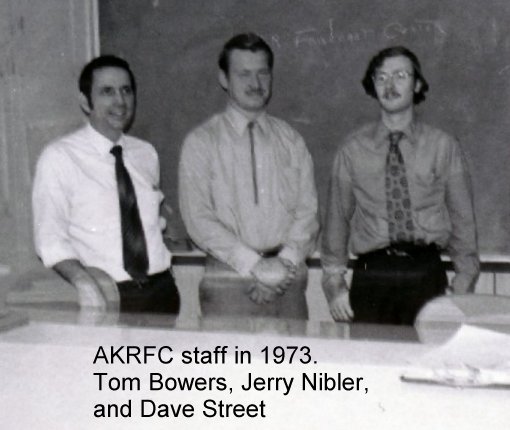 Jerry Nibler was transferred from the Alaska Region staff to the AKRFC in 1971, and David Street, a newly graduated hydrologist from the University of Maryland, was hired later that same year. Bowers, Nibler, Street and Marie Drew (the secretary) were the only staff for the AKRFC until 1974 when Dave Chapman was hired from the U.S.Army Corps of Engineers in Tulsa.
Jerry Nibler was transferred from the Alaska Region staff to the AKRFC in 1971, and David Street, a newly graduated hydrologist from the University of Maryland, was hired later that same year. Bowers, Nibler, Street and Marie Drew (the secretary) were the only staff for the AKRFC until 1974 when Dave Chapman was hired from the U.S.Army Corps of Engineers in Tulsa.
Dave Street developed most of the operational software used by the AKRFC in the 1970s and 80s. From a software standpoint in those days each River Forecast Center in the country was a stand-alone entity, though some centrally-supported software, such as the Sacramento Soil Moisture Accounting model, was used. The data base, communications, data retrieval, and the hydrologic forecast system at each office, however, were developed in-house and tailored to the individual office's needs. It wasn't until the mid-1980s that the NWS River Forecast System (NWSRFS) hydrologic model began to be implemented in the AKRFC, and then in a much different way than the rest of the country. The other Centers had a dedicated communication link to a mainframe computer in Washington DC on which they ran NWSRFS. NWSRFS was a modular group of hydrologic and data handling subroutines that were linked together by a mainline program. Many of the hydrologic subroutines were developed at various River Forecast Centers to model specific hydrologic functions. These local modules were incorporated into NWSRFS and supported centrally by the Office of Hydrology at NWS Headquarters. Communications, data basing, data display and product generation were the responsibility of the individual River Forecast Center. Because of high communications costs for a dedicated line to Washington DC, the AKRFC did not operate like the Lower 48 River Forecast Centers in the 1980s and early 1990s. The AKRFC continued to run its hydrologic models locally using components of the NWSRFS.
One contribution made by the AKRFC to the national effort was the extended streamflow prediction concept. This concept was proposed in a 1974 paper given by Jerry Nibler at a meeting outlining the AKRFC development and application of spring snow melt flood probabilities. The concept involves statistical Monte-Carlo simulation using a hydrologic model and a collection of time series of temperature and precipitation data to drive the model to produce a range of hydrographs from which probability inferences could be made about flood potential. The inspiration for this application came from Chester Kisel, a professor of hydrology at the University of Arizona in the late 1960s. This concept was later adopted and enhanced by the Office of Hydrology and incorporated into the National program.
When Glenn Audsley transferred to the NWS Southern Region Headquarters in Ft Worth in 1972, Tom Bowers convinced the Regional Director, Stew Bigler, that the Regional Hydrologist position and the HIC position could be merged and the duties performed by one person. From that time forward the Regional Hydrologist and the HIC were the same person in the AR. This was unique in the NWS.
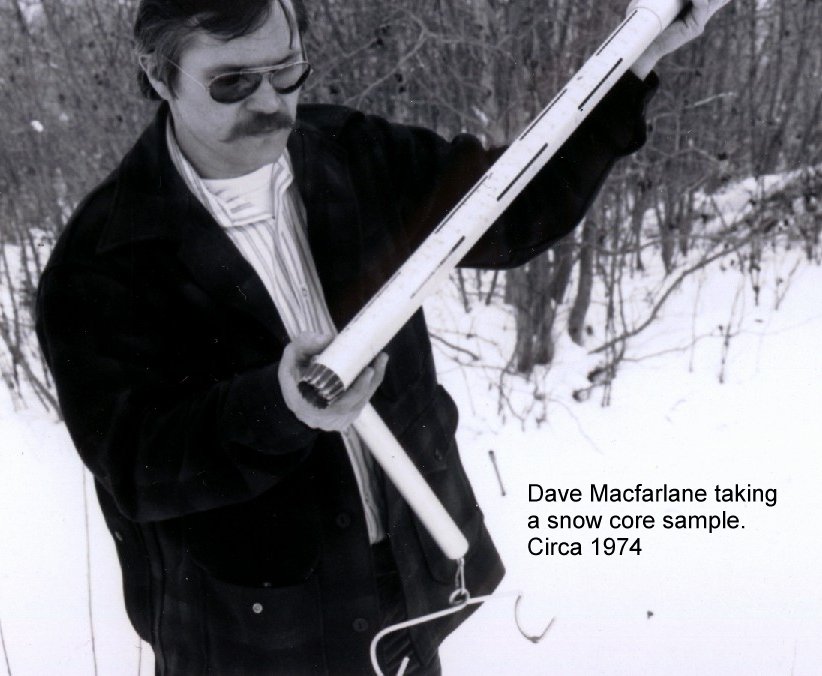 From 1970 to 1978 Dave Macfarlane was the hydro-tech at the Fairbanks Weather Service Forecast Office. Dave handled all of the northern Alaska field work and hydrologic office work at the River District Office in the Fairbanks office. His duties included much of the work now performed by the Service Hydrologist. In 1978, Dave was transferred to the AKRFC from the Fairbanks office in order to better utilize his position. Dave then became the hydro-tech for all of Alaska.
From 1970 to 1978 Dave Macfarlane was the hydro-tech at the Fairbanks Weather Service Forecast Office. Dave handled all of the northern Alaska field work and hydrologic office work at the River District Office in the Fairbanks office. His duties included much of the work now performed by the Service Hydrologist. In 1978, Dave was transferred to the AKRFC from the Fairbanks office in order to better utilize his position. Dave then became the hydro-tech for all of Alaska.
Based on the need to understand the relationship between rainfall and runoff in a sub-arctic environment, in 1974 the Office of Hydrology and Tom Bowers decided that research on cold regions river forecasting needed to be done. Dr. Henry Santiford was hired as a research hydrologist assigned to the Alaska Region hydrology staff to carry on this important work. Henry helped set up the instrumentation on the Caribou Poker Creek Experimental Watershed near Fairbanks. One of Henry's chief accomplishments was the test and evaluation of the meteorburst communications technology in Alaska. This technology was eventually adopted by a consortium of Federal agencies in Alaska as an operational communications system called the Alaska Meteorburst Communications System. Henry moved to Michigan as a Civil Engineering professor at Michigan Tech in 1979.
Julius Moor, one of the Alaska Region staff hydrologists, took a job with the World Meteorological Organization in Pakistan in 1976. Julius was a top notch field person and had a firm understanding of river ice processes. Tim Renchler was hired from the Alaska District of the Corps of Engineers to replace Julius. Tim became interested in commercial fishing and decided to pursue that endeavor full time in 1979. Also in 1979, the AKRFC along with the Anchorage Weather Service Forecast Office and the Alaska Regional Office moved from the Hill building to the new Federal Office Building located at 222 W 7th Ave in Anchorage.
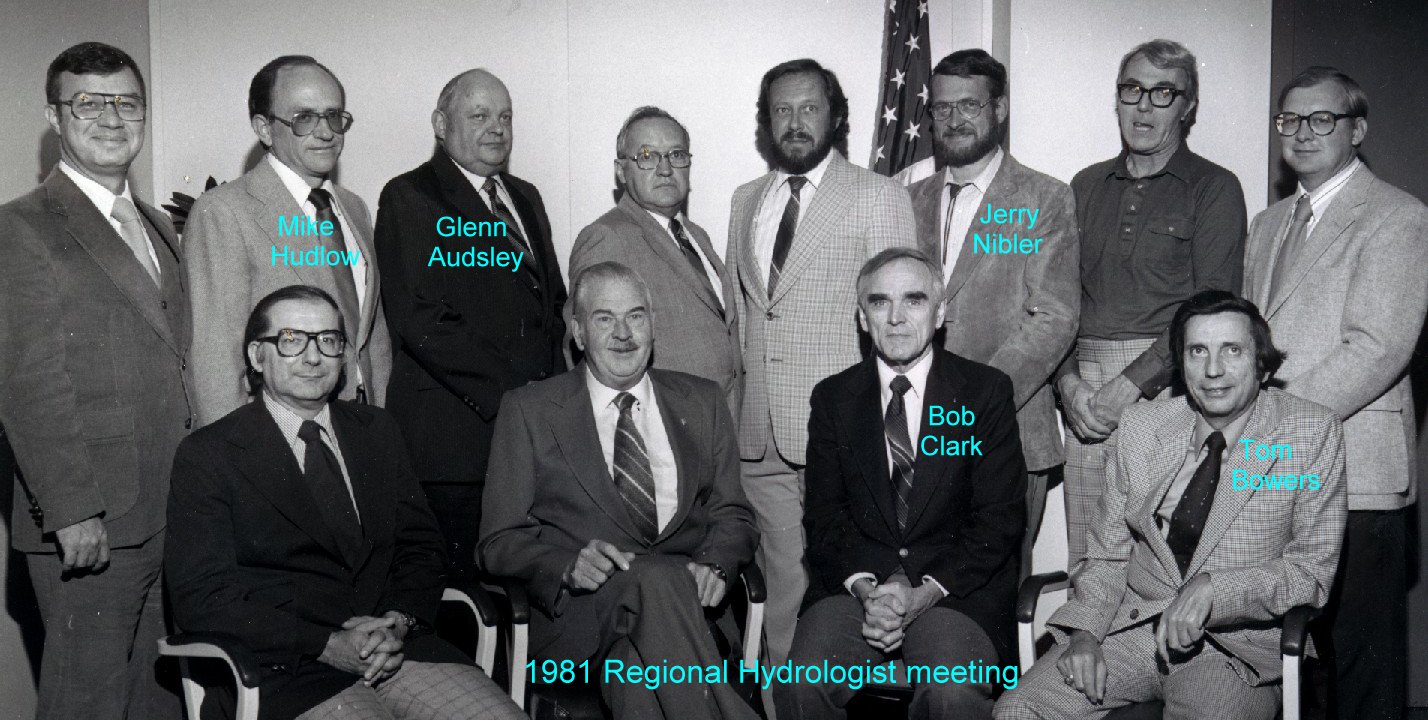 Tom Bowers transferred to the NWS Western Region as Regional Hydrologist in late 1979 and Jerry Nibler was selected as Regional Hydrologist for Alaska and the Hydrologist-in-Charge of the AKRFC in 1980. Jim Haertel came to the AKRFC from Lower Mississippi River Forecast Center in Louisiana in 1981. Bob Farrell, a meteorologist in the Anchorage Weather Service Forecast Office, also transferred into the AKRFC. Bob stayed for two years and moved back to the weather office. Ed May was hired to replace Bob Farrell. Ed stayed for two years and moved to the Des Moines Weather Service Forecast Office as service hydrologist in 1985. Ed was not replaced due to tight fiscal policy in the Alaska Region.
Tom Bowers transferred to the NWS Western Region as Regional Hydrologist in late 1979 and Jerry Nibler was selected as Regional Hydrologist for Alaska and the Hydrologist-in-Charge of the AKRFC in 1980. Jim Haertel came to the AKRFC from Lower Mississippi River Forecast Center in Louisiana in 1981. Bob Farrell, a meteorologist in the Anchorage Weather Service Forecast Office, also transferred into the AKRFC. Bob stayed for two years and moved back to the weather office. Ed May was hired to replace Bob Farrell. Ed stayed for two years and moved to the Des Moines Weather Service Forecast Office as service hydrologist in 1985. Ed was not replaced due to tight fiscal policy in the Alaska Region.
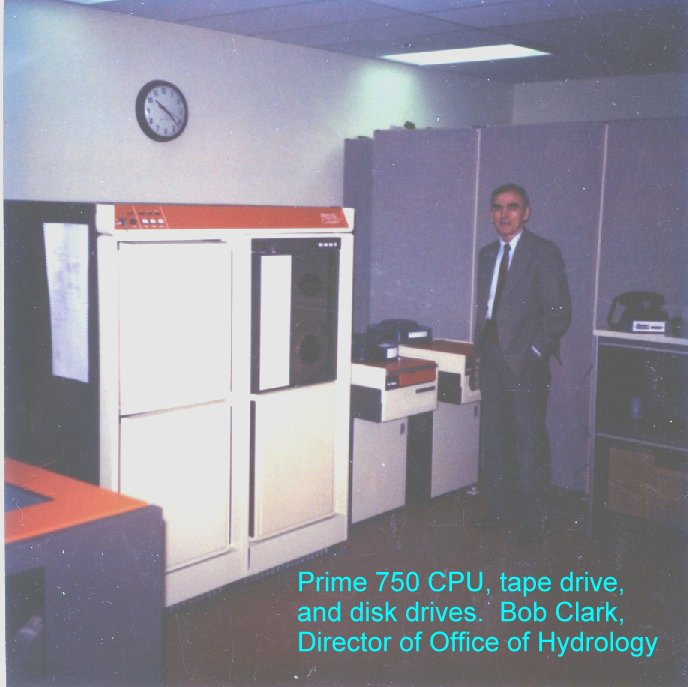 In late 1979 the IBM 1130 was replaced by a Prime 750 mini-computer. This was a big step forward, since the Prime was a multi-user machine with interactive terminals. Batch mode and punch cards were gone forever. The Regional Director set up a regional computer management group in 1980 with the Hydrologist-in-Charge as chairman. This appointment was a natural since the Prime 750 was procured for AKRFC operations with the Regional Office and the Anchorage Weather Service Forecast Office using it for a few operational and administrative functions. With time, the Hydrologist-in-Charge became, by default, the Alaska Region computer manager. This was an expanding and time consuming job since the Fairbanks and Juneau Weather Service Forecast Offices also wanted time on the Prime 750. In 1982, a decision was made at NWS Headquarters to exclude the Alaska Region from the nationally implemented Automation of Field Operations and Services (AFOS) computer and communication system, and money was made available for a second Prime 750 to handle the additional workload imposed by all of the Regions offices. A communications network was designed and implemented which tied the four operational offices together on the Prime 750. In place of AFOS, resourceful programmers in the Alaska Regional Office, the AKRFC and the three weather offices developed an alternative called Alaska Regional Computer Communications System (ARCCS). ARCCS employed a relatively simple communications architecture for the operational offices. The system matured during the 1980s, became relatively trouble free, and worked quite well. As technology continued to advance, though, the workstation concept with its individual user computers proved to be much more powerful than the mini-computer. After much deliberation and effort, the Alaska Region made the commitment to move to a networked workstation architecture for the operational offices in 1990 and the Hydrologist-in-Charge relinquished management of the Alaska Region computer systems to a full time computer manager position established in the Alaska Regional Office.
In late 1979 the IBM 1130 was replaced by a Prime 750 mini-computer. This was a big step forward, since the Prime was a multi-user machine with interactive terminals. Batch mode and punch cards were gone forever. The Regional Director set up a regional computer management group in 1980 with the Hydrologist-in-Charge as chairman. This appointment was a natural since the Prime 750 was procured for AKRFC operations with the Regional Office and the Anchorage Weather Service Forecast Office using it for a few operational and administrative functions. With time, the Hydrologist-in-Charge became, by default, the Alaska Region computer manager. This was an expanding and time consuming job since the Fairbanks and Juneau Weather Service Forecast Offices also wanted time on the Prime 750. In 1982, a decision was made at NWS Headquarters to exclude the Alaska Region from the nationally implemented Automation of Field Operations and Services (AFOS) computer and communication system, and money was made available for a second Prime 750 to handle the additional workload imposed by all of the Regions offices. A communications network was designed and implemented which tied the four operational offices together on the Prime 750. In place of AFOS, resourceful programmers in the Alaska Regional Office, the AKRFC and the three weather offices developed an alternative called Alaska Regional Computer Communications System (ARCCS). ARCCS employed a relatively simple communications architecture for the operational offices. The system matured during the 1980s, became relatively trouble free, and worked quite well. As technology continued to advance, though, the workstation concept with its individual user computers proved to be much more powerful than the mini-computer. After much deliberation and effort, the Alaska Region made the commitment to move to a networked workstation architecture for the operational offices in 1990 and the Hydrologist-in-Charge relinquished management of the Alaska Region computer systems to a full time computer manager position established in the Alaska Regional Office.
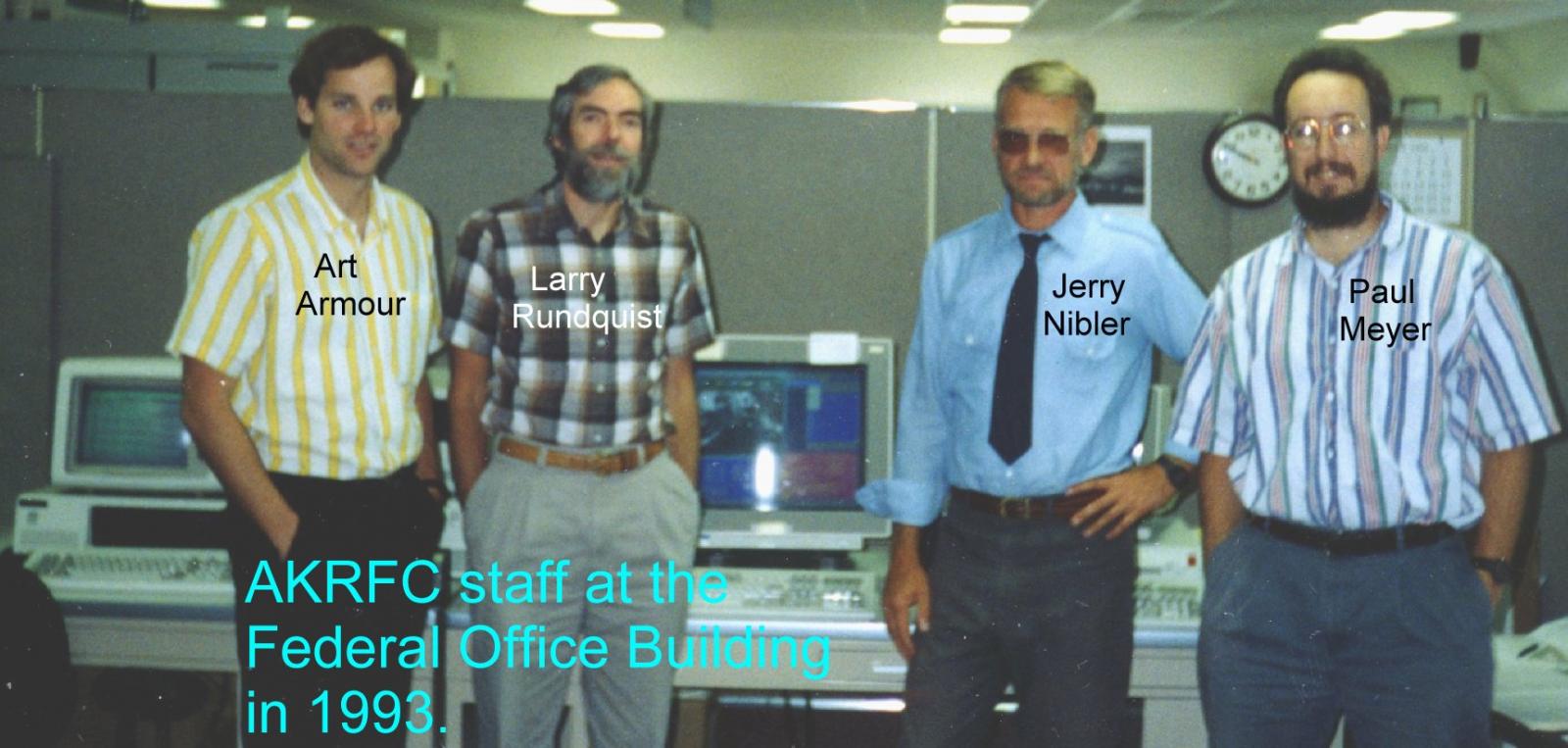 Dave Street left in 1987 to take a position in the Office of Hydrology at NWS Headquarters in Silver Spring, Maryland and Paul Meyer was hired to fill Dave's vacancy the same year. Paul had been working for the University of Alaska in Anchorage and picked up where Dave left off, developing and maintaining the AKRFC software, and keeping operations going. Jim Haertel moved to Minnesota in 1987 and was replaced by Dr. Larry Rundquist that same year. Larry came to the NWS from the private consulting world in Anchorage. In 1990 Dave Chapman retired and moved to Tulsa, Oklahoma. He was replaced by Art Armour, a newly minted hydrologist from the University of Arizona. Dave Macfarlane retired from the NWS to a farming operation in the Palmer area in 1992. Dave was not replaced due tight fiscal policy at the Alaska Region.
Dave Street left in 1987 to take a position in the Office of Hydrology at NWS Headquarters in Silver Spring, Maryland and Paul Meyer was hired to fill Dave's vacancy the same year. Paul had been working for the University of Alaska in Anchorage and picked up where Dave left off, developing and maintaining the AKRFC software, and keeping operations going. Jim Haertel moved to Minnesota in 1987 and was replaced by Dr. Larry Rundquist that same year. Larry came to the NWS from the private consulting world in Anchorage. In 1990 Dave Chapman retired and moved to Tulsa, Oklahoma. He was replaced by Art Armour, a newly minted hydrologist from the University of Arizona. Dave Macfarlane retired from the NWS to a farming operation in the Palmer area in 1992. Dave was not replaced due tight fiscal policy at the Alaska Region.
The next major change in the Alaska Region hydrology program came with the NWS 1990's modernization effort. This brought the only increase in AKRFC staffing since 1978 with the addition of the Hydrometeorological Analysis and Support (HAS) group, the Development and Operations Hydrologist (DOH), and the Hydro-Tech/Administrative Assistant. In addition, Service Hydrologist positions were established at the Fairbanks and Anchorage weather offices with the Anchorage Service Hydrologist serving the Juneau office as well.
The original HAS group consisted of Arleen Lunsford, John Papineau and Scott Lindsey. Becky Perry was the first Hydro-tech/administrative assistant in the AKRFC, Christine McGeehee was the first Service Hydrologist in Fairbanks, and Jeff Perry was the original Service Hydrologist in Anchorage. This group all came on board in 1994. Larry Rundquist was selected as the Development and Operations Hydrologist and Scott Lindsey moved into the senior hydrologist position vacated by Larry.
Technology also made a big step forward for hydrology with the NWS modernization. Seven WSR-88D Doppler weather radars were installed in Alaska in the 1990s. These added valuable information to help solve the precipitation estimation problem. Though the WSR-88D radar coverage was limited, it did provide information on some key flood prone drainages in the Fairbanks and Anchorage areas and along portions of the North Gulf of Alaska coast. The hydrologic software developed and fielded with the new high powered computer and communications system, Advanced Weather Interactive Processing System (AWIPS), in 1999 provided a centrally supported software package that went a long way toward freeing the hydrologists and meteorologist from computer systems support and permitted more time to be devoted to operational and scientific problems. In September 1995 the AKRFC and the Anchorage Weather Forecast Office, along with a new group called the Alaska Aviation Weather Unit, moved from the Federal Office Building in downtown Anchorage to the new NWS operations building located at 6930 Sand Lake Road, just south of Anchorage International Airport.
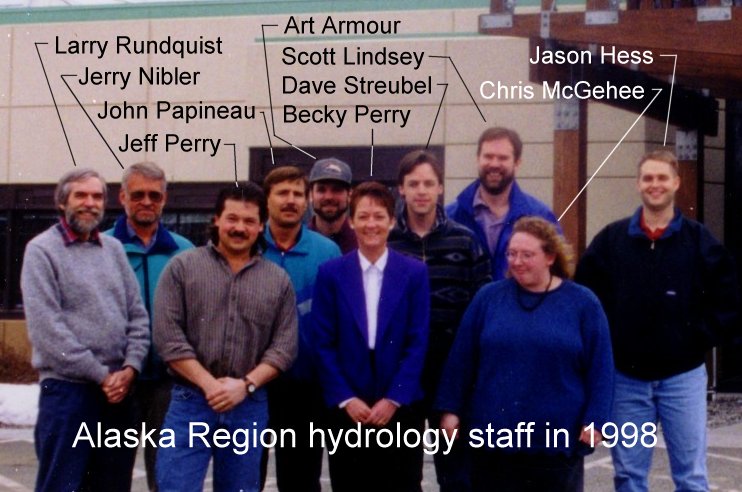 Paul Meyer worked in the AKRFC until September 1995, when he transferred to the Northeast River Forecast Center in Taunton, Massachusetts. Art Armour replaced Paul as senior hydrologist dealing with software. Jeff Perry was selected as the Senior HAS Forecaster. Jason Hess moved from a forecaster position in the Anchorage Weather Service Forecast Office to the Anchorage Service Hydrologist position vacated by Jeff. Dave Streubel, who had worked summers in the AKRFC, was hired full time to replace Art as journeyman hydrologist.
Paul Meyer worked in the AKRFC until September 1995, when he transferred to the Northeast River Forecast Center in Taunton, Massachusetts. Art Armour replaced Paul as senior hydrologist dealing with software. Jeff Perry was selected as the Senior HAS Forecaster. Jason Hess moved from a forecaster position in the Anchorage Weather Service Forecast Office to the Anchorage Service Hydrologist position vacated by Jeff. Dave Streubel, who had worked summers in the AKRFC, was hired full time to replace Art as journeyman hydrologist.
Another change came in 1997, when the AKRFC accepted technical responsibility for the NWS Pacific Region's hydrology program. This included Hawaii, Guam, American Samoa, and the Federated States of Micronesia. The Alaska River Forecast Center was renamed the Alaska-Pacific River Forecast Center (APRFC) in 2000 to better reflect the change in responsibilities.
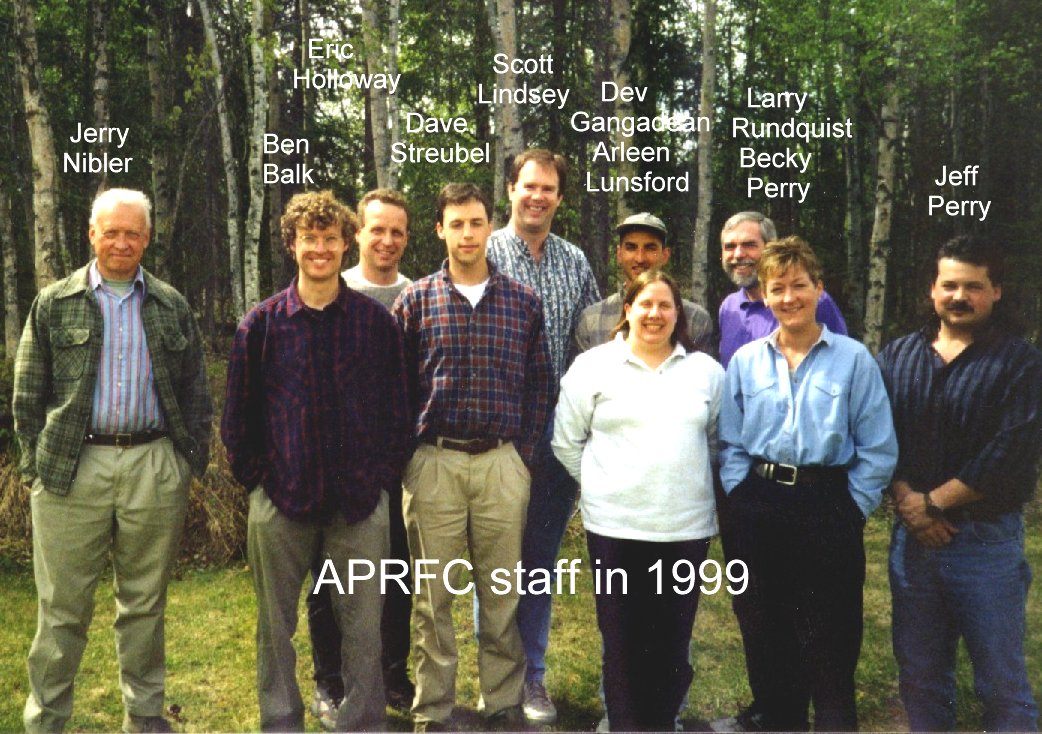 Jason Hess moved to the Wakefield, Virginia, Weather Forecast Office in 1998 and was replaced by John Papineau from the HAS group in the AKRFC. Eric Holloway came from the Grand Junction Weather Forecast Office to replace John Papineau on the HAS staff. In 1998, Art Armour moved to Michigan and Dave Streubel moved into Art's senior hydrologist position. Dev Gangadean was hired from the University of Arizona to fill in behind Dave Streubel. In 1999, Ben Balk was hired to fill in behind Ed May who vacated the journeyman hydrologist position in 1985. Ben came fresh from graduate school at Colorado State University. Also in 1999 Christine McGeehee left Fairbanks for the Southeast River Forecast Center in Atlanta. Eric Stevens came north from Marquette, Michigan, Weather Forecast Office to replace Christine as Fairbanks' Service Hydrologist in January 2000. Jerry Nibler retired from the NWS in July of 2000, having spent thirty years in Alaskan hydrology. Robin Radlein was selected to replace Jerry and arrived in November of 2000.
Jason Hess moved to the Wakefield, Virginia, Weather Forecast Office in 1998 and was replaced by John Papineau from the HAS group in the AKRFC. Eric Holloway came from the Grand Junction Weather Forecast Office to replace John Papineau on the HAS staff. In 1998, Art Armour moved to Michigan and Dave Streubel moved into Art's senior hydrologist position. Dev Gangadean was hired from the University of Arizona to fill in behind Dave Streubel. In 1999, Ben Balk was hired to fill in behind Ed May who vacated the journeyman hydrologist position in 1985. Ben came fresh from graduate school at Colorado State University. Also in 1999 Christine McGeehee left Fairbanks for the Southeast River Forecast Center in Atlanta. Eric Stevens came north from Marquette, Michigan, Weather Forecast Office to replace Christine as Fairbanks' Service Hydrologist in January 2000. Jerry Nibler retired from the NWS in July of 2000, having spent thirty years in Alaskan hydrology. Robin Radlein was selected to replace Jerry and arrived in November of 2000.
In June 2002, Dev Gangadean left the APRFC to successfully pursue a goal of driving from Prudoe Bay on the north coast of Alaska on summer solstace (Jun 21) to Ushuaia, Argentina on the southern tip of South America on winter solstace (Dec 21). In summer of 2002, Eric Stevens was selected to be a lead forecaster in the Fairbanks WFO. Ed Plumb was selected from the Juneau WFO to become service hydrologist at the Fairbanks WFO. Jim Coe was selected from the staff at the Lower Mississippi River Forecast Center in July 2003 to fill Dev Gangadean's vacated position.
In August 2008, Dave Streubel left the APRFC for a Hydrologist position in the Science and Service Division of the NWS Western Region Headquarters, located in Salt Lake City, Utah. His move provided a vacancy that allowed APRFC to fill a new position called the Service Coordination Hydrologist (SCH). The SCH, like the Warning Coordination Meteorologist in the Weather Forecast Office, is responsible for office outreach and coordination of the office's products and services to meet the needs of its users. Larry Rundquist had been doing many of the outreach tasks for the office as the Development and Operations Hydrologist (DOH) and was selected as the SCH. Scott Lindsey was selected to fill the DOH position and Ben Balk and Jim Coe advanced from Hydrologists to Senior Hydrologists. In February 2009, James "Jamie" Montesi was hired as a Hydrologist from the Anchorage office of the NRCS Snow Survey Program.
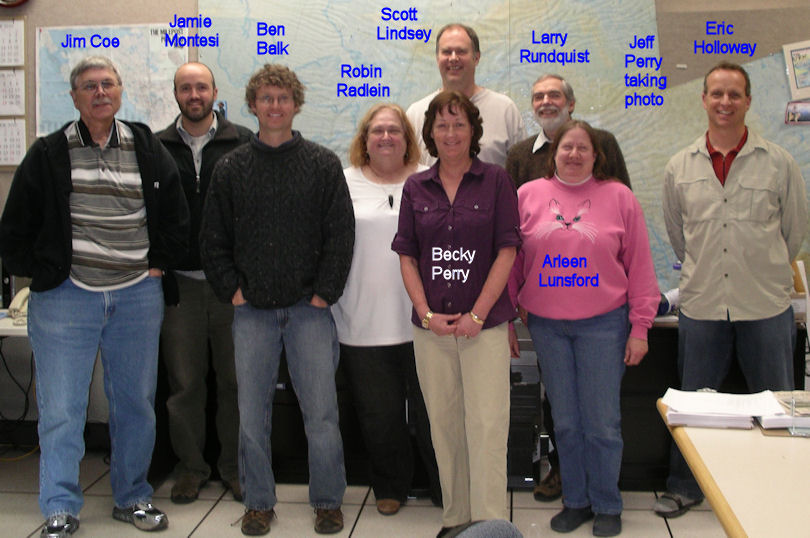 In November of 2010, Jamie Montesi moved to California to take a job with NOAA National Marine Fisheries Service in Arcata, California to work on the Klamath Basin Restoration project, which involves the potential removal of the lower four dams on the Klamath River. At the same time, Scott Lindsey moved to the Service Coordination Hydrologist position and Larry Rundquist to the DOH position in anticipation of Larry's retirement. Celine Van Breukelen was selected to fill Jamie's vacated position and she started in January of 2011. Celine came to the APRFC from University of Alaska Fairbanks with a Masters degree in civil engineering with a focus in hydrology. Larry Rundquist retired from APRFC at the end of January 2011 with over 23 years of service. Dave Streubel was selected to fill the DOH and returned to Alaska after a few years in Western Region Headquarters in April of 2011. With some changes in staffing in the Alaska Region, the RFC gained a new position and Jeff Perry was selected to be the first Information Technology Officer (ITO). In the summer of 2012, Kurt Mayer was hired to fill the vacant Senior HAS position.
In November of 2010, Jamie Montesi moved to California to take a job with NOAA National Marine Fisheries Service in Arcata, California to work on the Klamath Basin Restoration project, which involves the potential removal of the lower four dams on the Klamath River. At the same time, Scott Lindsey moved to the Service Coordination Hydrologist position and Larry Rundquist to the DOH position in anticipation of Larry's retirement. Celine Van Breukelen was selected to fill Jamie's vacated position and she started in January of 2011. Celine came to the APRFC from University of Alaska Fairbanks with a Masters degree in civil engineering with a focus in hydrology. Larry Rundquist retired from APRFC at the end of January 2011 with over 23 years of service. Dave Streubel was selected to fill the DOH and returned to Alaska after a few years in Western Region Headquarters in April of 2011. With some changes in staffing in the Alaska Region, the RFC gained a new position and Jeff Perry was selected to be the first Information Technology Officer (ITO). In the summer of 2012, Kurt Mayer was hired to fill the vacant Senior HAS position.
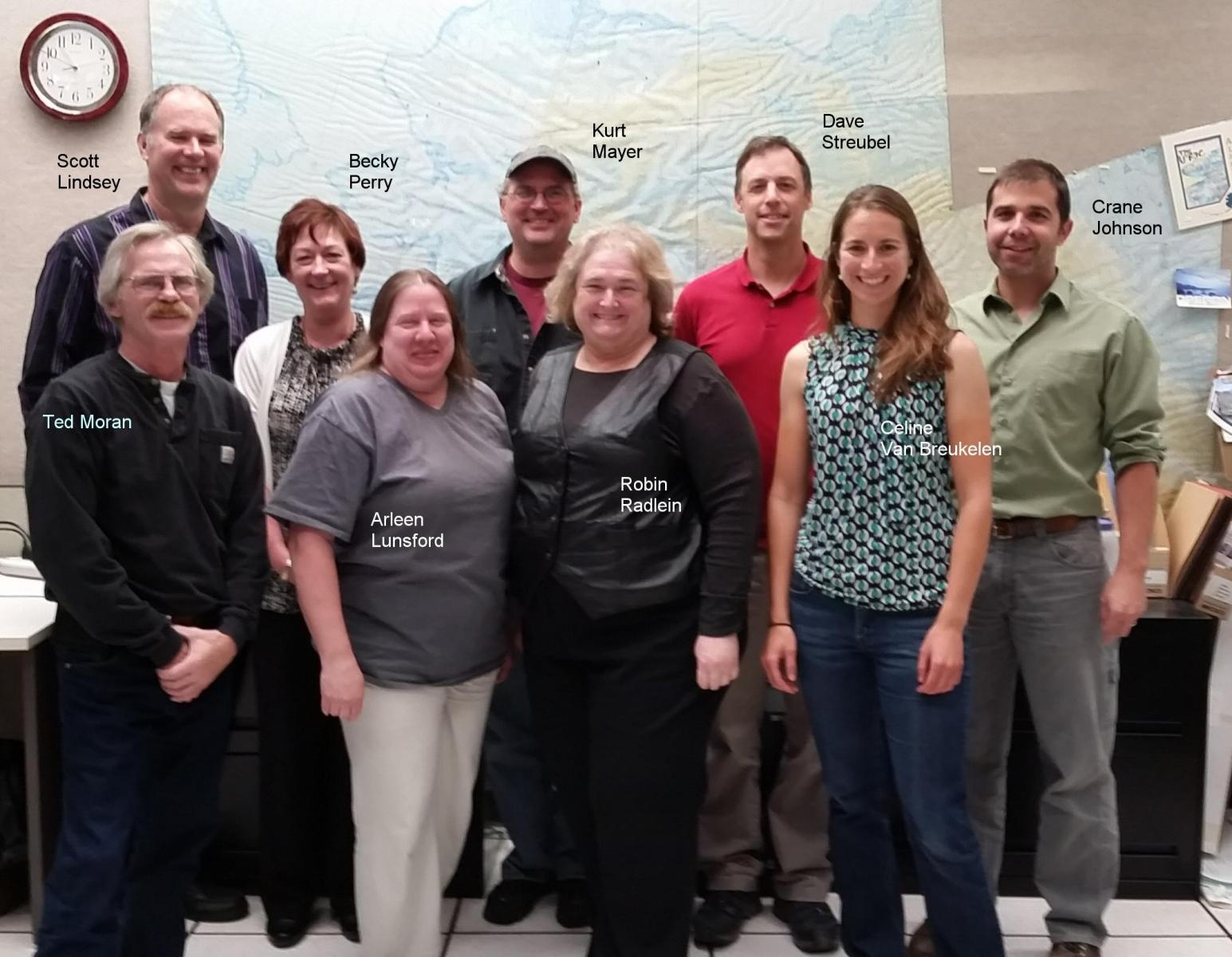
Ben Balk left the NWS for the private sector in the spring of 2013 and Jim Coe retired at the end of July 2013. January of 2014 was a difficult month for the RFC as we first received the news that Jim Coe had passed away down in Seattle and a few days later our friend and colleague, Jeff Perry passed away at his home. We will miss them both. 2014 would provide many more changes. In February, Crane Johnson was hired away from the Alaska District of the US Army Corps of Engineers. At the same time, Edward "Ted" Moran was hired away from the US Geological survey and the two long-standing Senior Hydrologist positions were finally filled. Finally in October of 2014, Robin Radlein retired as the HIC after 38 years of federal service, and shortly after that, Rob Oslund was hired to fill the vacant Information Technology Officer position. In January of 2015, Scott Lindsey was hired as the HIC.
In January, 2017, Dr. Jessica Cherry joined the APRFC staff as a Senior Hydrologist from her position as a professor at the University of Alaska Fairbanks. The RFC staff had worked with Jessie for a number of years so she was a very welcome addition and was able to integrate quickly and add to staff expertise with her knowledge of remote sensing and snow modeling and her contacts with the academic and private sector. Kurt Mayer left in the fall of 2017 to take an ITO position at WFO Honolulu and Rob Oslund left in May of 2018 transferring to the ITO position at WFO La Crosse (Wisconsin). Finally, Celine Van Breukelen got a promotion and moved a few cubicles away from her old location in November of 2018 as the Senior Service Hydrologist in the Anchorage WFO.
Kyle Van Peursem transferred from the Anchorage Weather Forecast office to the APRFC in February 2019 as a senior hydrometeorologist. In March 2020, just as the Covid-19 was beginning to impact operations, Michelle McAuley and Johnse Ostman joined the APRFC. Michelle was hired on as a hydrometeorologist from the Anchorage WFO. Johnse was hired from the USGS as a hydrologist. Jessica Sanow was hired in 2021 as a hydrologist from Colorado State University and the BLM. Scott moved on to be the Regional Director and Crane Johnson took over as the HIC. In late 2021, Ted Moran and Arleen Lunsford decided to retire and Jessie Cherry left the RFC to take the NOAA Regional Climate Services Director for Alaska position. Josh Walston was hired on as a hydrometeorologist from Reno, NV to replace Arleen. In December 2021, Celine Van Breukelen came back to the APRFC from the SSH position to fill in the SCH.
2022 saw quite a few changes at the RFC. Jess Sanow moved back to the lower 48 to take a position with the US Forest Service in Colorado. Justin Fisher moved up from Minnesota, trading forecasting at the North Central RFC for an opportunity to work and live in Alaska.
From a river forecasters viewpoint, Alaskan hydrology is much more complex than that encountered in more temperate latitudes. The effects of snow, glaciers, jokulhlaups, river ice, rain, and snowmelt runoff, coupled with the complicated topographic influences on the precipitation regime all combine to make river forecasting in Alaska interesting. Add to that the fact that Alaska has a hydrologic data collection network that is ten times less dense than the Lower 48 network and you have a considerable challenge.
One hydrologic phenomena that poses a regular threat of flooding is the annual spring ice breakup on the rivers. Aerial reconnaissance of the breakup process by NWS hydrologists and disaster experts from the Alaska Division of Emergency Services (ADES) has been on ongoing activity since the late 1960s. The Corps of Engineers provided a hydrologist or engineer as part of the reconnaissance team from the beginning but their participation ended when the Federal budgets became pinched in the 1980s. The reconnaissance team concept of operations has worked very well to fulfill the mission of both the ADES and the NWS. Experimental use of synthetic aperture radar satellite data in the late 1990s has proven the ability of the SAR data to enable river ice monitoring from the computer screen and will one day supplement, if not supplant, the reconnaissance team effort.
Glacier dammed lake outbursts, or jokulhlaups, are another phenomena of importance to the Alaska public warning program. NWS hydrologist have been regularly monitoring glacier dammed lakes on Snow, Skilak, and Triumvirate glaciers since 1970. During the building of the Trans-Alaska oil pipe line they also began to monitor lakes associated with Tazlina and Nelchina glaciers in the Copper River Basin.
In the 45 years from 1965 to 2010 the hydrologic problems have remained the same. As the population of Alaska grew during this period so did the requirement for hydrologic services. Advances in technology for data collection, data processing, communications, and data basing as well as the use of more sophisticated modeling have helped improve the service the NWS hydrology program provides to the public. The challenge remains formidable but very interesting.
The Personnel of the Alaska Region Hydrology Program
Regional Hydrologist for the NWS Alaska Region
| Otto Prexis | 1965-1967 | Returned to Office of Hydrology |
| Glen Audsely | 1968-1972 | From Cincinnati River Forecast Center; left to become NWS Southern Region Regional Hydrologist |
| Tom Bowers | 1972-1979 | From Cincinnati River Forecast Center; left to become NWS Western Region Regional Hydrologist |
| Jerry Nibler | 1980-2000 | From AKRFC; retired to split time between Alaska and Arizona (died 4/2003) |
| Robin Radlein | 2000-2014 | From NWS Headquarters; retired |
| Scott Lindsey | 2015-2021 | From APRFC; left to become the NWS Alaska Region Director |
| Crane Johnson | 2021-present | From APRFC |
NWS Alaska Region Hydrology Staff
| Bob Eckdale | 1965-1969 | Hydro-tech |
| Curt Green | 1968-1969 | Hydrologist on Alaska Region staff; left for private business in Anchorage |
| Julius Moor | 1969-1976 | Hydrologist from US Army Corps of Engineers in Anchorage; left for United Nations World Meteorological Organization in Pakistan (died 4/96) |
| Jerry Nibler | 1970-1971 | Hydrologist from University of Arizona; assigned to AKRFC |
| Henry Santeford | 1974-1979 | Research hydrologist from National Science Foundation; left to go to Michigan Technical University |
Hydrologist in Charge of the AKRFC (APRFC since 2000)
| Tom Bowers | 1971-1979 | From Cincinnati River Forecast Center; left to become NWS Western Region Regional Hydrologist |
| Jerry Nibler | 1980-2000 | From AKRFC; retired to split time between Alaska and Arizona (died 4/2003) |
| Robin Radlein | 2000-2014 | From NWS Headquarters |
| Scott Lindsey | 2015-2021 | From APRFC; Retired to become the NWS Alaska Region Director |
| Benjamin "Crane" Johnson | 2021-date | From APRFC |
AKRFC Staff (APRFC since 2000)
| Tom Bowers | 1971- 1979 | From Cincinnati River Forecast Center; left to become NWS Western Region Regional Hydrologist |
| Jerry Nibler | 1971- 2000 | Hydrologist from Alaska Region staff, selected as RH/HIC in 1980 (died 4/2003) |
| David Street | 1971-1987 | Hydrologist from University of Maryland; went to Office of Hydrology at NWS Headquarters |
| David Chapman | 1974-1990 | Hydrologist from US Army Corps of Engineers in Tulsa, Oklahoma; retired 7/90 to Tulsa |
| David Macfarlane | 1978-1992 | Hydrotech from Fairbanks Weather Forecast Office; retired 4/92 |
| Tim Renchler | 1976-1979 | Hydrologist from US Army Corps of Engineers in Anchorage; left to go commercial fishing in Alaska |
| Jim Heartel | 1981-1987 | Hydrologist from Lower Mississippi River Forecast Center in New Orleans; moved to State of Minnesota |
| Bob Farrell | 1981-1983 | Hydrologist/meteorologist from Anchorage Weather Service Forecast Office; returned to that office |
| Ed May | 1983-1985 | Hydrologist/meteorologist from Minneapolis Weather Service Forecast Office; moved to Des Moines Weather Service Forecast office as Service Hydrologist |
| Paul Meyer | 1987-1995 | Hydrologist from University of Alaska (AEIDC); moved to Northeast River Forecast Center in Taunton, Massachusetts |
| Larry Rundquist | 1987-2011 | Hydrologist from private consulting in Anchorage; retired 2/11 |
| Arthur Armour | 1990-1998 | Hydrologist from University of Arizona; resigned to move to Michigan |
| Scott Lindsey | 1994-2021 | Hydrologist from Office of Hydrology in NWS Headquarters |
| Arleen Lunsford | 1994-2021 | HAS meteorologist from private sector in Tulsa. Retired. |
| John Papineau | 1994-1998 | HAS meteorologist from Colorado State University; transferred to Anchorage Weather Forecast Office as Service Hydrologist |
| Becky Perry | 1995-2019 | Hydro Tech from Alaska Regional Headquarters, retired. |
| Jeff Perry | 1995-2013 | HAS meteorologist/First Information Technology Officer: from Anchorage Weather Forecast Office |
| Dave Streubel | 1995-2008 | Hydrologist from University of Arizona; left for a Hydrologist position in the Science and Service Division of the NWS Western Region Headquarters |
| Dev Gangadean | 1998-2002 | Hydrologist from University of Arizona; left in 6/02 to accomplish an adventurous goal |
| Eric Holloway | 1999-2021 | HAS Meteorologist from Grand Junction Colorado Weather Forecast Office; left for a position with the NWS Alaska Region Regional Operations Center (ROC) |
| Benjamin Balk | 1999-2013 | Hydrologist from Colorado State University; left for private industry |
| Jim Coe | 2003-2013 | Hydrologist from Lower Mississippi River Forecast Center in Slidell, Mississippi; Retired |
| Jamie Montesi | 2009-2010 | Hydrologist from the NRCS, Anchorage office; left for position with National Marine Fisheries Service in California in 11/10 |
| Celine Van Breukelen | 2011-2018 | Hydrologist from University of Alaska Fairbanks; left for Senior Service Hydrologist position in Anchorage Weather Forecast Office |
| Dave Streubel | 2011-date | Hydrologist returning to Alaska from Western Region (Salt Lake City) |
| Kurt Mayer | 2012-2017 | Senior HAS Meteorologist from NWS in Minnesota; left for ITO Position in Honolulu, HI |
| Benjamin "Crane" Johnson | 2014-date | Hydrologist from US Army Corps of Engineers, Alaska District. |
| Edward "Ted" Moran | 2014-2021 | Hydrologist from US Geological Survey, Columbia Environmental Research Center, Columbia, MO. Retired. |
| Robert Oslund | 2014-2018 | Information Technology Officer from WFO Glasgow, Montana; left for ITO position at Weather Forecast Office in La Cross WI |
| Jessica Cherry | 2017-2021 | Hydrologist from the University of Alaska Fairbanks; left to become NCEI Regional Climate Services Director for Alaska |
| Kyle Van Peursem | 2019-date | HAS forecaster from the Anchorage Weather Forecaster Office. |
| Michelle McAuley | 2020-date | HAS forecaster from the Anchorage Weather Forecaster Office. |
| Johnse Ostman | 2020-date | Hydrologist from the Alaska US Geological Survey, Anchorage, AK. |
| Jessica Sanow | 2021-2022 | Hydrologist from Colorado State University; left to take a hydrologist position with the Forest Service in Colorado |
| Josh Walston | 2021-date | HAS forecaster from Reno, NV. |
| Celine Van Breukelen | 2021-date | Service Hydrologist from Anchorage WFO. |
| Justin Fisher |
2022-date |
Hydrologist from the North Central River Forecast Center |
| Bob Busey | 2022- date | Hydrologist from the University of Alaska Fairbanks |
| Michael Ottenweller | 2022- date | HAS forecaster from the Anchorage Weather Forecast Office. |
Service Hydrologist at Fairbanks Weather Forecast Office
| Dave Macfarlane | 1971-1978 | Hydrotech at Fairbanks Weather Service Forecast Office; transferred to AKRFC |
| Christine McGeehee | 1994-1999 | From New Orleans Weather Forecast Office; left for Southeast River Forecast Center in Atlanta, Georgia |
| Eric Stevens | 1999-2002 | From Marquette, Michigan, Weather Forecast Office; left for lead forecaster position in Fairbanks WFO |
| Ed Plumb | 2002-2017 | From Juneau Weather Forecast Office; promoted to WCM position at Fairbanks WFO |
| Karen Endres | 2017-2022 | From USDA Forest Service, Wrangell AK; Retired |
| Ed Plumb | 2022-date | From the Fairbanks Weather Forecast Office. |
Service Hydrologist at Anchorage Weather Forecast Office
| Jeff Perry | 1994-1995 | Forecaster at Anchorage Weather Forecast office; transferred to AKRFC |
| Jason Hess | 1995-1998 | Forecaster at Anchorage Weather Forecast office; transferred to Wakefield, Virginia, Weather Forecast Office |
| John Papineau | 1998-2012 | From AKRFC, left government service |
| Andrew Dixon | 2016-2018 | Forecaster at Anchorage Weather Forecast office; transferred to Senior Service Hydrologist Position in Grand Rapids, MI |
| Celine Van Breukelen | 2018-2021 | Promoted from Hydrologist position at APRFC |
| Marian Baker | 2022-date | Hydrologist form the National Water Center |
Service Hydrologist at Juneau Weather Forecast Office
| Aaron Jacobs | 2012-present | Forecaster at Juneau Weather Forecast office; transferred to Senior Service Hydrologist Position |